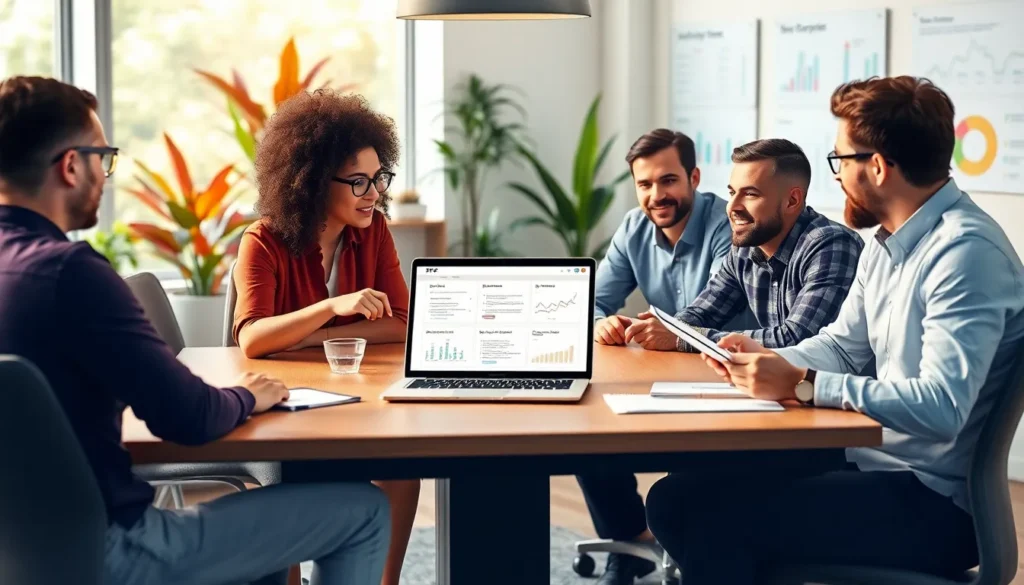Table of Contents
ToggleIn a world where multitasking is the norm and attention spans are shorter than a cat video, taking notes can feel like trying to catch smoke with your bare hands. But fear not! Digital tools and resources are here to save the day and your sanity. Imagine transforming your scribbles into organized masterpieces that not only make sense but also dazzle your peers.
From sleek apps that sync across devices to clever plugins that turn your notes into interactive wonders, the possibilities are endless. Whether you’re a student drowning in lecture notes or a professional juggling meetings, these digital marvels can amplify your note-taking game to new heights. So grab your favorite device and get ready to unleash the full potential of your notes—because who says note-taking can’t be a little fun?
Understanding Digital Tools for Note Amplification
Digital tools significantly enhance the note-taking process. Apps like Evernote, OneNote, and Notion offer features to organize and synchronize notes across devices. Students often opt for these platforms due to their robust functionalities, which include tagging, searching, and multimedia integration.
Features like voice recognition allow users to capture spoken lectures effortlessly. This capability transforms auditory information into text, ensuring no vital detail is lost. Additionally, many applications support cloud storage, granting access from any device connected to the internet.
Visual organization serves as another advantage offered by digital tools. Mind mapping software, such as XMind and MindMeister, enables users to create structured diagrams that represent relationships between concepts. This visual approach enhances comprehension and retention.
Collaboration becomes seamless with tools like Google Docs, allowing multiple users to view and edit notes in real time. Students working in groups can collectively contribute to shared documents, fostering a more dynamic learning environment.
Integrations with other applications further amplify productivity. Tools such as Zapier connect various apps, automating workflows based on user-defined triggers. This customization reduces repetitive tasks, streamlining the note-taking experience.
Utilizing digital assistants aids in task management alongside note-taking. Applications like Todoist and Trello help users prioritize assignments and deadlines efficiently. Integrating these tools can lead to enhanced organization and ultimately better academic performance.
These digital resources prove that enhancing note-taking doesn’t limit to traditional methods. Embracing these innovations elevates the overall experience, making information capture more efficient and enjoyable.
Types of Digital Tools
Digital tools enhance the note-taking process, making it simpler and more effective. Below are key categories that benefit users in organizing and optimizing their notes.
Note-Taking Apps
Note-taking apps offer a streamlined approach to capturing thoughts. Evernote allows users to tag notes for easy retrieval. OneNote supports multimedia integration, enabling images and audio to enrich notes. Notion stands out with customizable databases for different note formats. Students particularly appreciate these platforms for their flexibility and synchronization across devices. Voice recognition features in apps capture lectures seamlessly, preserving essential information without missing context. Accessibility in cloud-based applications ensures notes are available on any device, fostering continual learning.
Productivity Software
Productivity software enhances organizational skills alongside note-taking. Google Docs facilitates real-time collaboration, letting multiple users edit documents simultaneously. Task management tools like Todoist prioritize assignments based on deadlines, aiding effective time management. Trello employs a visual interface to track projects through boards and lists, supporting users in managing tasks dynamically. Integrations with automation tools like Zapier reduce manual effort, streamlining workflows and enhancing efficiency. Utilizing productivity software promotes a more structured approach to studying and professional projects.
Integrating Digital Resources
Digital resources significantly enhance the note-taking process, providing various solutions for better organization and productivity. Utilizing these tools can improve efficiency and collaboration.
Cloud Storage Solutions
Cloud storage solutions, like Google Drive and Dropbox, enable seamless access to notes from any device. Syncing happens automatically, ensuring the latest updates are always available. Additionally, users can securely share files with classmates or colleagues, enhancing collaboration. With ample storage space, important documents can remain organized and accessible. The backup capability protects against data loss, giving users peace of mind.
Online Collaboration Tools
Online collaboration tools, such as Google Docs and Microsoft OneNote, facilitate live editing and feedback. Multiple users can contribute simultaneously, promoting an interactive discussion around notes. Commenting features allow for easy clarification of points, ensuring understanding. These tools help streamline group projects by centralizing information. Real-time updates make it simple to track changes and maintain version control, improving the overall organization of collaborative efforts.
Benefits of Using Digital Tools
Digital tools significantly enhance the note-taking process. They offer various advantages that transform how individuals capture and utilize information.
Enhanced Organization
Organized notes lead to better comprehension. Digital tools allow users to categorize and tag content, making retrieval easier. Users can create folders for different subjects or projects, resulting in a streamlined system. Features like search functionality enable quick access to specific notes or keywords. Furthermore, mind mapping software provides a visual structure, helping clarify complex ideas. Apps with multimedia integration let users incorporate images, videos, and links, enriching the content and context. Thus, organized notes foster a better understanding of the material.
Improved Accessibility
Accessibility plays a crucial role in effective note-taking. Digital tools ensure notes are available from any device with internet access. Cloud storage solutions, like Google Drive, enable users to store and share documents securely. Synchronization across devices means updates are reflected instantly, allowing users to access the latest information. Additionally, mobile apps let individuals capture thoughts on the go, ensuring they never miss important details. Collaboration features in tools such as Google Docs facilitate contributions from peers, enhancing the learning experience. Consequently, improved accessibility leads to a more effective and engaging note-taking process.
Best Practices for Effective Note Amplification
Effective note amplification requires strategic usage of digital tools. Prioritizing consistency across platforms makes note-taking smoother and more reliable.
Consistency in Usage
Users should establish a regular approach to utilizing their selected digital tools. Regular use of applications like Evernote or OneNote facilitates familiarity, enabling quicker navigation and enhanced retrieval of information. Keeping a standard format for notes promotes clarity, allowing users to easily identify key concepts. Synchronization across devices provides seamless access, which is essential for maintaining workflow. Consistent tagging and categorization methods support organized notes and encourage better review practices.
Customization and Personalization
Tailoring digital tools to individual preferences significantly enhances the note-taking experience. Customizable features in applications provide opportunities to adapt layouts, colors, and fonts, aligning with personal styles. Users can utilize templates within tools like Notion to standardize information presentation, boosting readability. Integrating multimedia elements, such as images or videos, adds a personal touch while reinforcing comprehension of complex topics. Preferences in notification settings assist in managing reminders and deadlines, resulting in better task completion rates. Personalization fosters engagement and ultimately improves retention of information.
Embracing digital tools for note amplification transforms the way individuals capture and organize information. By leveraging apps and resources that enhance accessibility and collaboration, users can streamline their note-taking process and improve retention. The combination of multimedia integration and real-time collaboration fosters a more engaging learning environment.
When individuals adopt these digital solutions, they not only enhance their organizational skills but also adapt to the fast-paced demands of modern life. With the right tools in hand, note-taking becomes a more enjoyable and productive experience, paving the way for academic and professional success.










